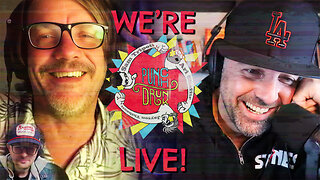Premium Only Content

How to find if virus single-stranded or double-stranded?
Virus Replication
Viruses are intracellular obligate parasites which means that they cannot replicate or express their genes without the help of a living cell. A single virus particle (virion) is in and of itself essentially inert. It lacks needed components that cells have to reproduce. When a virus infects a cell, it marshals the cell's ribosomes, enzymes and much of the cellular machinery to replicate. Unlike what we have seen in cellular replication processes such as mitosis and meiosis, viral replication produces many progeny, that when complete, leave the host cell to infect other cells in the organism.
Viruses may contain double-stranded DNA, double-stranded RNA, single-stranded DNA or single-stranded RNA. The type of genetic material found in a particular virus depends on the nature and function of the specific virus. The exact nature of what happens after a host is infected varies depending on the nature of the virus. The process for double-stranded DNA, single-stranded DNA, double-stranded RNA and single-stranded RNA viral replication will differ. For example, double-stranded DNA viruses typically must enter the host cell's nucleus before they can replicate. Single-stranded RNA viruses however, replicate mainly in the host cell's cytoplasm.
Once a virus infects its host and the viral progeny components are produced by the host's cellular machinery, the assembly of the viral capsid is a non-enzymatic process. It is usually spontaneous. Viruses typically can only infect a limited number of hosts (also known as host range). The "lock and key" mechanism is the most common explanation for this range. Certain proteins on the virus particle must fit certain receptor sites on the particular host's cell surface.
How Viruses Infect Cells
The basic process of viral infection and virus replication occurs in 6 main steps.
Adsorption - virus binds to the host cell.
Penetration - virus injects its genome into host cell.
Viral Genome Replication - viral genome replicates using the host's cellular machinery.
Assembly - viral components and enzymes are produced and begin to assemble.
Maturation - viral components assemble and viruses fully develop.
Release - newly produced viruses are expelled from the host cell.
Viruses may infect any type of cell including animal cells, plant cells and bacterial cells. To view an example of the process of viral infection and virus replication, see Virus Replication: Bacteriophage. You will discover how a bacteriophage, a virus that infects bacteria, replicates after infecting a bacterial cell.
-
 LIVE
LIVE
SpartakusLIVE
2 hours agoHUGE NEW UPDATE - Aim Assist NERF, New META, New MOVEMENT || #1 King of Content
378 watching -
 18:42
18:42
Navy Media
2 hours agoHouthis ATTACK the Wrong U.S. Fighter Jet – Then THIS Happened…
13 -
![battlefield 6 with the crew! [RGMT CONTENT Mgr. | RGMT GL | GZW CL]](https://1a-1791.com/video/fwe2/7f/s8/6/w/D/y/F/wDyFz.0kob.c.jpg) LIVE
LIVE
XDDX_HiTower
52 minutes agobattlefield 6 with the crew! [RGMT CONTENT Mgr. | RGMT GL | GZW CL]
33 watching -
 LIVE
LIVE
Nikko Ortiz
2 hours agoVirtual Reality Milsim... | Rumble LIVE
137 watching -
 LIVE
LIVE
StevieTLIVE
1 hour agoNEW UPDATE Warzone WINS w/ The Fellas
81 watching -
 9:00:32
9:00:32
Dr Disrespect
10 hours ago🔴LIVE - DR DISRESPECT - WARZONE x BLACK OPS 7 - SEASON 1 INTEGRATION
129K6 -
 1:25:00
1:25:00
Sam Tripoli
2 hours ago $0.44 earnedPunch Drunk Sports LIVE!
620 -
 55:45
55:45
MattMorseTV
1 hour ago🔴Trump scores 3 VICTORIES in ONE DAY.🔴
4.05K14 -
 LIVE
LIVE
Badlands Media
7 hours agoSITREP Ep. 137
1,210 watching -
 1:53:04
1:53:04
Barry Cunningham
5 hours agoLIVE BREAKING NEWS: President Trump And Melania Trump Host The National Christmas Tree Lighting
60.4K9